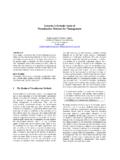Transcription of Artifacts: Examples Domain #1 Planning and Preparation
1 Artifacts: Examples The sample artifacts and evidence below are illustrative in nature and do not represent a comprehensive list. Domain # 1 planning and preparation Framework Guidelines Artifacts/Actions to Illustrate Proficiency 1a Demonstrating knowledge of content Artifacts should show that the teacher is remaining up-to-date with and pedagogy current pedagogical practice Content knowledge List of content-area courses taken to advance Prerequisite relationships content/pedagogical knowledge Content pedagogy List of workshops attended related to teacher's content/pedagogical area/district initiative List of presentations made at
2 Conferences/meetings pertaining to content-related material List of articles/books written for professional journals/publishers that pertain to a teacher's content area List of websites visited/used that pertain to content-related material/Common Core State Standards (CCSS)/district initiatives List of content-related/pedagogical webinars that teacher participated in (include dates and certificates of completion, if provided). List of free online courses (MOOCs, Itunes, Coursera, etc.) that teacher took to advance content/pedagogical knowledge (include dates and certificates of completion, if provided).
3 List of courses taught at upper-level institutions Examples of student work that show relevant, meaningful comments made by the teacher, comments that illustrate the teacher's content/pedagogical strengths Summer reading lists and summer Preparation Unit plans, lesson plans, and/or assignments incorporating best practices Shared content knowledge with peers Pre-service and in-service training Active involvement in Professional Learning Communities (logs, team agendas). A teacher-developed list of common student misperceptions 1b Demonstrating knowledge of Lists of accommodations made for individual students students Lists of modifications made for students with IEPs/504s Child development Examples of differentiation in the classroom different Learning processes handouts/exercises/assignments geared for specific learning Special needs groups Student skills, knowledge and Examples of instructional scaffolding in the classroom proficiency Unit plans, lesson plans.
4 And/or assignments Interests and cultural heritage Communication with families Instructional grouping techniques Student profile worksheets Index cards with student information Lesson plans reflecting differentiated instruction, awareness of students needing accommodations and developmental and cognitive readiness 1c Setting instructional outcomes Lesson plans (units) aligned to curriculum guides/CCSS. Value Instructional outcomes are listed on the board prior to class Sequence and alignment instruction Clarity Examples of activities/units that display a spectrum of outcomes Balance (basic understanding/comprehension; high-level thinking.)
5 Suitability for diverse learners communication [written/spoken]; etc.). Assessments that show outcomes are being achieved in your classroom Curriculum map Evidence of modified curriculum (intervention plans, IEPs, enrichment). PLC/Team agendas and minutes that include unit/lesson Planning notes 1d Demonstrating knowledge of Examples of diverse resources used in the classroom (print and resources electronic). For classroom Supplemental materials you provide or recommend for your To extend content knowledge students - after-school tutoring, supplemental coursework, etc.
6 For students Explanations of how you use aides and specialists in your classes Professional journals you regularly read and consult Unit plans and/or lesson plans Evidence of collaboration and learning with peers and colleagues Record of human resources ( , speakers, parent volunteers, civic groups, museums, classroom visitors, field trips). Demonstration/use of school/community resources List of resources with varying levels to accommodate students 1e Designing coherent instruction Unit plans that exhibit Learning activities 1.
7 Coherence (methods, materials, assessments all work together). Instructional materials and 2. Variety of instructional activities and methods resources 3. Problem-based learning Instructional groups 4. Student choice Lesson and unit structure 5. Higher order thinking activities Unit plans and/or lesson plans showing progression of conceptual complexity Curriculum map Teacher and student reflection of lessons, learning, or feedback (written or oral). Intellectually challenging tasks Concept Map Advanced Organizer Meaningful/respectful tasks 1f Designing student assessments A variety of formative/summative assessments connected to Congruence with outcomes classroom instruction/outcomes Criteria and standards Rubrics used to evaluate student work Formative assessments Examples of student assessments with teacher comments Use for Planning Varied assessment techniques meeting all learning styles Performance assessment tasks Student-designed assessment Assignments
8 And assessments including standards that are clearly identified Domain #2 The Classroom Environment Framework Guidelines Artifacts/Actions to Illustrate Proficiency 2a Creative an environment of respect To be observed during classroom observation and Teacher has positive, meaningful interaction with students Rapport Students have positive, meaningful interaction with each other Teacher interaction with students, Students feel comfortable in the classroom, with the instructor Student interaction with students and with each other 2b Establishing a culture for learning To be observed during classroom observation Importance of content Students are actively engaged and care about what they are Expectations for learning and doing (Not going through motions).
9 Achievement Teacher encourages high level thinking/has high expectations Student pride in work Classroom displays student work Classroom has visual aids that enhance the learning process Student pride in work Energy and commitment of the teacher 2c Managing classroom procedures To be observed during classroom observation Instructional groups Classroom rules are posted and students are aware and follow Transitions them. Materials and supplies Teacher makes effective use of class time (bell to bell teaching). Non-instructional duties Small groups work efficiently and students take initiative within Supervision of volunteers and those groups/groups are monitored by teacher paraprofessionals Teacher has clear plan for non-instructional tasks passing out papers, taking attendance, bathroom passes, etc.
10 Teacher makes effective use of aides/para-professionals Efficient functioning of the classroom Organization of supplies/resources Smooth transitions Effective use of adults in the classroom 2d Managing student behavior Logs of parent contacts pertaining to student Expectations behavior(phone/email/meeting). Monitoring behavior To be observed during classroom observation Response to misbehavior Students are actively engaged in the class Students are monitored and know the rules of the class Students monitor their own behavior Student conduct Teacher response to student behavior 2e Organizing physical space To be observed during classroom observation Safety and accessibility Classrooms are organized for effective teaching Arrangement of furniture and Classroom is safe (cords, computers, heavy objects, etc.)







